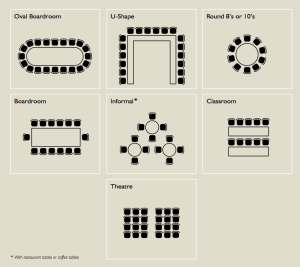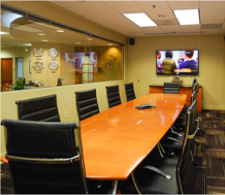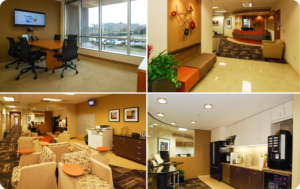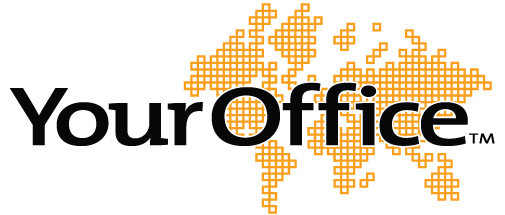When planning a meeting there are a many things that you need to consider. How long will it be? What needs to be discussed? Who needs to be there? These are common questions to be answered in order for a meeting to be successful. However have you considered how the room will be laid out? This may seem like an unnecessary consideration but room lay out can make or break a productive meeting.
There are four basic styles to choose from when determining which layout is best for your meeting. Take a few minutes to determine what the integral aspects of your meeting will be. Will there be a presentation? Will it be a large group of passive listeners or smaller group with lots of interaction? Will you have numerous handouts or do the participants need to take notes? Once you have a basic idea of what your meeting will entail then you can decide which room layout will work best for you.
Classroom
This style sounds exactly like what it is. It’s laid out in a similar way as a classroom. You will need several rows of conference tables and chairs all facing the front of the room. This type of setup is ideal for meetings that include a presenter and lots of passive participants. Note-taking and laptop computers are easily integrated into the meeting and if there are multiple handouts and reference material there is plenty of space for that as well.
This type of set-up will be ineffective if you are expecting any type of collaboration, as most of the participants will merely be seeing the backs of the other people present. However, if interaction is not necessary and the meeting will be longer or will include refreshments this set up may be just right.
Theatre Seating
This style is similar to the classroom setup only without the tables. Seats should be arranged in rows facing the main focal point at the front of the room. This can either be a head table, a stage, or even simply a speaker. If the group is larger and there is no need for note taking or any type of participation then this style is ideal.
If there will be no handouts, reference materials, or refreshments and if you have a medium to large sized group then this style will be the most effective as it will encourage the participants to focus solely on the front of the room to the speaker or speakers.
U-Shape Style
For this style you’ll need several conference tables arranged in the shape of the letter U with chairs around the outside of the U. This style is good for meetings where there is a main presenter or presentation but the participants are encouraged to contribute as well. This style is well suited for committee meetings, discussion groups, and Board of Directors meetings.
If you have a small group and you need to encourage interaction between participants than the U-Shape set up may work well. With the tables arranged in such a way there is also ample room for reference materials, note taking, and a general workspace.
Boardroom Setup
This setup is often used for smaller groups where everyone is able to freely communicate with one another and there is a shared workspace. It is arranged with one oval or rectangular table with chairs all around. This style is also used for discussion groups, committee meetings, and Board of Directors meetings as long as the group will be small.
This setting will also not work if you plan to have any type of audio-visual presentation or a head speaker. If you’re looking for a setup that encourages interaction, has decent shared workspace, and will include only a small group of participants then the boardroom setup should work perfectly.
Deciding on the right set-up is essential for a productive meeting. By doing a little preparation and choosing the right setup style you can be sure that your next meeting is a success.




